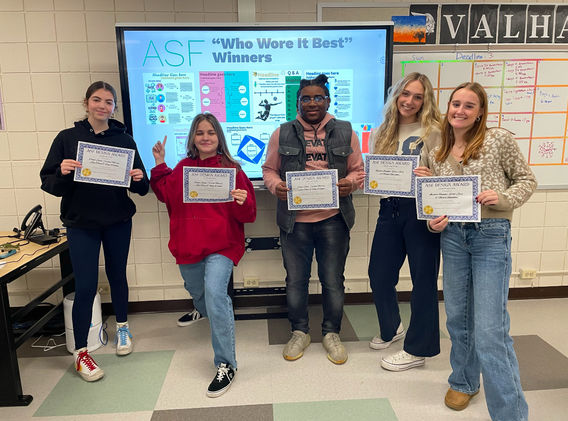Isabella Boedeker
Managing Editor
Editing, Leadership, & Team Building
At the end of the 2024 school year, our executive board team was established, and we were eager to start preparing for the 2024-25 school year. My fellow Editor-in-Chief, Katie Madigan, attended the MIPA Leadership Workshop, while I participated in the MIPA summer camp "Art of Storytelling" course. During this week-long program, I dedicated hours to refining my news, feature and editorial writing, learning new skills to enhance our publication’s multimedia elements, and gaining strategies for fostering a healthy classroom environment. I also received valuable feedback on our executive team’s vision statement and how to apply it:
“This year, we aim to elevate our current designs and stories, creating a more interactive publication and digital platform that prioritizes inclusivity, creativity, and timeliness. We will support one another through clear communication, early development of journalistic skills, and the establishment of straightforward guidelines that uphold journalistic integrity.”
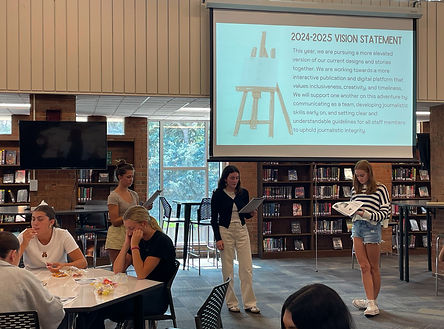

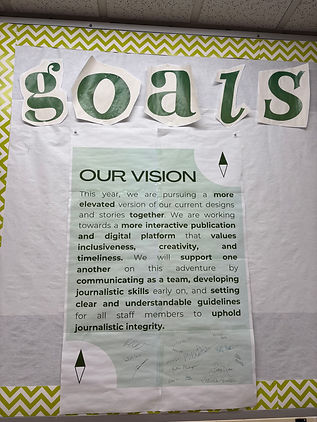
Editing
As the managing editor, I often serve as the final review for stories, page designs, and more. It’s my responsibility to finalize the work and guide the class in incorporating their last comments and solutions.

Creating the spread planner
My executive team and I are responsible for developing stories for print, web, and social media. In class, we collaborate in groups to brainstorm ideas, but ultimately, we determine which stories are most suitable for the publication by verifying dates and sources.
Second reads
At first, being the final eye on a story felt intimidating, especially transitioning from doing first reads to second reads. However, I've learned to provide constructive feedback and identify mistakes that might be missed in the initial review. It requires patience, as I sometimes find myself noticing the same errors repeatedly, but this is what leadership is all about.
1. “Got it”
Picking up second reads through Basecamp.


2. Leaving comments
Sometimes a long process, as often I have to go back and leave more comments to ensure a quality result.
3. “Doubledeker”


Indicating the story is signed off and ready to be placed on the page/web.

Page reads


At the beginning of each issue, the editors create a mock-up design of their page, and the other managing editor and I provide feedback and contribute our ideas on how the page should look. While I'm not directly designing the pages, my input and guidance are essential to the process.
In addition, I conduct page reads, which involves approving the final design and leaving comments for any last-minute adjustments.

Web Drafts
The other managing editor and I publish the website drafts after our web editors create them. We ensure that the online version matches the print and the Google documents. While it may seem like a straightforward task, it can be tricky, as errors sometimes occur when transferring content into SNO.
Leadership
I was incredibly nervous during my interview to join the executive board, but I took a moment to breathe and focus on the positive impact I could make as a leader. To me, leadership means being constantly observed, with all eyes on you, so it's important to lead by example. Journalism has shaped my understanding of leadership, and I truly believe that a paper wouldn’t run smoothly without strong leadership.

The Editorial Board, or Ed Board, is made up of the executive team, page editors, website editors, and social media editors. Every month, we hold a meeting to select a topic for the paper, ensuring it ties into a major story. During these sessions, we brainstorm ideas and, throughout the year, collaborate to set collective goals and strategies to improve our publications.
Editorial Board meetings

Production night
Production night takes place once every issue, after school, when all the editors gather to design their pages. As a member of the executive board, I support the page editors, helping troubleshoot any challenges that arise. While it can be a stressful experience, the energy of working alongside the entire team fosters a unique sense of camaraderie. Despite the pressure, it's an opportunity for all of us to bond and grow closer as a group.



Alongside my advisor, editor-chief, and co-managing editor, it is our responsibility to stay another day of the month to lock the pages. This means finalizing designs, checking for mistakes, choosing what pages have color, and making sure the paper follows through with its intended purpose. As we go through all 16 pages we develop new ideas for the next issue, and elements that can be improved, but also always reflect on the positive elements. As one of the managing editors, it’s my job to foster an engaging classroom environment and guide others to write and design with power, to ensure a productive lock night.
Lock Night

Mentorship
To me, mentorship means being understood and having someone to look up to. From the moment you enter this class, you’re paired with either a mentor or a mentee. For the first issue, you work together on a story, which helps you identify their strengths and areas for growth, allowing you to guide them throughout the year. Since my promotion to staff reporter, I’ve had the opportunity to mentor four journalists—one editor, one distribution manager, and two others who are planning to be interviewed for editor positions. I’ve always looked up to my mentor as an intern, so being able to mentor others has been very meaningful to me. As managing editor, I prioritize connecting with everyone, striving to be approachable and open to communication while also acting as a mentor to all.
Mini lessons
Click the images to see the full lesson.
For our mini-lesson, my co-managing editor and I focused on adding a human element to ledes. We noticed many lacked a personal touch or specific moment. To address this, we photographed teachers' classrooms, capturing small details. Students wrote observations, formulated questions for the teacher, and crafted ledes with a human focus. Since North Pointe runs for two hours, we presented during both sessions. The first hour had some clarity issues, but we quickly adjusted, making the second hour smoother. Overall, the lesson helped writers develop more engaging ledes by emphasizing emotion and specificity in their storytelling.
For my mini-lesson on news writing, I focused on strengthening connections to our school community. MIPA’s critique highlighted the need for more impactful ties to North. To engage students, I analyzed a strong example of a locally connected story. Then, students read a timely news article and took a quiz to stay informed. This led to brainstorming potential sources and interview questions. I emphasized the importance of crafting strong questions that elicit meaningful responses, revealing how a story affects its subjects—whether students, staff, or community members. The lesson reinforced the value of local relevance in making stories more compelling.
News Poster
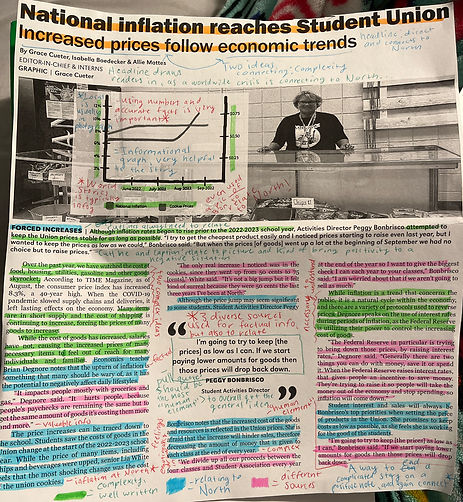
In response to my mini-lesson on connecting news stories back to North, I created a poster analyzing a national news story. This poster is displayed in the room as a reminder of how to tie stories back to North, highlighting elements like the headline, artwork, pull quotes, and more.
Updated Readership Survey
During the summer, I took the initiative to update our readership survey to better reflect the student body’s views on each section of our paper. I revamped the questions to gather more accurate insights into how students engage with our content and to evaluate whether the new elements we've introduced are actually beneficial.
Click the image to view the survey.
North Pointe Open House
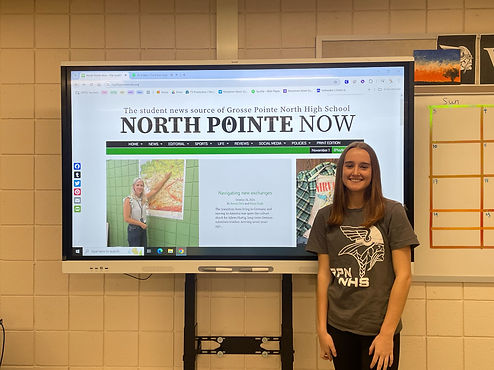
During both the 2023 and 2024 school years, I collaborated with my advisor at our school’s open house, where incoming freshmen learned about North Pointe and what we do. I helped showcase our paper, website, and social media to give visitors an understanding of our daily tasks, while also highlighting our fun competitions and discussing the benefits of the course. I am proud to be a part of this program—it’s easy for me to brag about something I believe in so much.

Guest Writing

Going the "extra mile"

Leadership is about more than just a title; it’s about going the extra mile. There have been many times I’ve assisted others with their stories, but one moment that stands out is when a section editor asked for help with photography on their photo story. Despite my initial intimidation with the camera, I stepped in and gained confidence in using it. North Pointe is a program where everyone supports each other, and I will always be there to lend a hand.
Click here to see the photos I captured.

Team-building
Team-building is essential because it fosters collaboration, ensuring that everyone’s strengths contribute to producing high-quality work. A strong team also helps us support each other, share diverse perspectives, and work efficiently under tight deadlines.
Ice-breakers
The sense of community and family within the North Pointe production room is one of the main reasons I'm excited to come to work each day. However, that connection doesn’t happen overnight. At the start of each year, many of our class periods begin with an icebreaker. While icebreakers are often dreaded and can feel uncomfortable or boring, that's not the case in North Pointe.
Click the images to view my ice-breakers.
For my icebreaker, we played "Two Truths and One Lie," which was a great way for the class to get to know each other, especially since not everyone was familiar with one another. It was simple and straightforward, yet it provided an effective opportunity for me to lead the class.
The social media editor and I gathered everyone’s favorite songs and created a staff playlist that we listened to throughout the year. For the icebreaker, we made a worksheet with all the songs and a fill-in-the-blank section where students had to match each song to its owner. It was a fun and engaging activity, and it was interesting to learn about our classmates' musical tastes.
Distribution Day
Distribution day is the day where all the hard work pays off, and many smiles are shared between my class and the school. During distribution, me and the Editor-in-Chief recognize students who went above and beyond, and I love seeing their faces bright up when we announce that. Distribution day is also special to me because as the managing editor I overlook many stories, page designs, and pick what stories go in the paper; so seeing it all come together in a cohesive and connecting way is truly a rewarding feeling.
Why leadership?
After three years of journalism, I can confidently say that I’ve grown into a leader, but I wouldn't be where I am without my team. Journalism is so meaningful to me because of the people I’ve worked with, and I’ll always be grateful for the friendships I’ve built along the way. Flip through the photos to see the connections I’ve made.


















